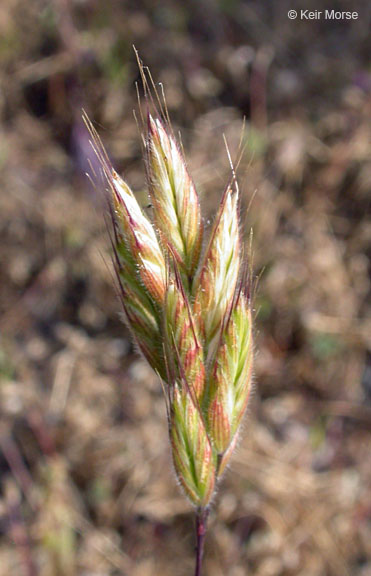
Interactions With Other Organisms
Interactions with Humans
Bromus hordeaceus is one of plenty of species that are very problematic in many different continents. This Brome invades fields that are good for farming and interrupts the growth and nutrient acquisition of the surrounding crops (Andersson et al. 2002). This is harmful to humans in that it makes it harder for farmers and gardeners to grow crops because its seeds can remain ungerminated for over a year in the soil and emerge after the soil has been sowed, in other words, Bromus hordeaceus's seeds can remain dormant for over a year (Andersson et al. 2002).
Symbiotic Mutualism
Organism that have a mutualistic and
symbiotic relationship with Bromus hordeaceus's roots are
endomycorrhizal fungi, specifically arbiscular mycorrhizal fungi,
which can actually help the grass’s roots grow and help increase the
reproductive rates of the grass (Antolin
2008). We do not know what specific species of arbiscular
mycorrhizal fungi have this relationship with Bull Grass, but the
fungi that do this are from the Glomeromycota phylum. If you take
Organismal Biology (at UW-La Crosse,
BIO 203), you would learn about mycorrhizal and endomycorrizal fungi
having these kinds of relationships with plants; mycorrhizal and
endomycorrhizal fungi lower the
 resources used by the plants in making
roots because the fungi will help increase the amount of resources
that the plants' roots absorb by increasing their roots' surface
area in exchange for resources that the fungi would need. They also
protect plants' roots. Having a symbiotic and mutualistic
relationship means that both organisms are living together where
both benefit from each other, and this relationship definitely
describes that between arbiscular fungi and Bromus hordeaceus.
resources used by the plants in making
roots because the fungi will help increase the amount of resources
that the plants' roots absorb by increasing their roots' surface
area in exchange for resources that the fungi would need. They also
protect plants' roots. Having a symbiotic and mutualistic
relationship means that both organisms are living together where
both benefit from each other, and this relationship definitely
describes that between arbiscular fungi and Bromus hordeaceus.
Competition
In many areas of California and southwestern Oregon (more information in the Habitat page), Bromus hordeaceus is one of two dominant annual plants; the other being the Broad-leaved filaree (Erodium botrys) which has codominance with B. hordeaceus (Howard 1998). "Red brome (B. rubens) and Cutleaf filaree (E. cicutarium)" generally replace "Soft chess and Broad-leaved filaree as dominants in portions of the Central Valley..." (Howard 1998). Another competitor is Bromus tectorum or Cheatgrass (also mentioned in the Habitat page)
Predation
Soft cheat (one of the common names for Bromus hordeaceus) does not have any predatory interactions itself, but it is invasive and harmful to some native organisms in the areas where it has been introduced as a non-native organism (Ainouche et al. 1999).
Being an autotrophic organism, or a
producer, Soft chess (another one of the common names for Bromus hordeaceus)
acquires its food from the soil and from the sun through
photosynthesis and nutrient uptake with the aid of water cohesion.
Because it is a producer and on the bottom of the food web, many
organisms (mainly herbivores) eat Bromus hordeaceus such as cattle,
deer (like the
White-Tailed Deer), domestic goats, horses, rabbits, domestic sheep, other small
mammals, and some birds (Howard
1998).
Go Back Home? See the References?
Go to MultipleOrganisms.net!